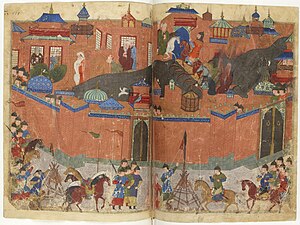Battle of Baghdad (1258)
| Siege of Baghdad (1258) | |||||||
|---|---|---|---|---|---|---|---|
| Part of the Mongol invasions | |||||||
 Hulagu's army besieging the walls of Baghdad |
|||||||
|
|||||||
| Belligerents | |||||||
| Commanders and leaders | |||||||
|
|
|
||||||
| Units involved | |||||||
| 40,000+ Mongols, mainly cavalry 12,000 Armenian cavalry 40,000 Armenian infantry Georgian infantry 1,000 Chinese bombardiers and engineers Turkic and Persian soldiers |
Cavalry Infantry |
||||||
| Strength | |||||||
| 120,000–150,000 | 50,000 | ||||||
| Casualties and losses | |||||||
| Unknown but believed to be minimal | 50,000 soldiers, 200,000–800,000 civilians (Western sources) 2,000,000 civilians (Arab sources) |
||||||
The Siege of Baghdad, which lasted from January 29 until February 10, 1258, entailed the investment, capture, and sack of Baghdad, the capital of the Abbasid Caliphate, by Ilkhanate Mongol forces and allied troops. The Mongols were under the command of Hulagu Khan (or Hulegu Khan), brother of the khagan Möngke Khan, who had intended to further extend his rule into Mesopotamia but not to directly overthrow the Caliphate. Möngke, however, had instructed Hulagu to attack Baghdad if the Caliph Al-Musta'sim refused Mongol demands for his continued submission to the khagan and the payment of tribute in the form of military support for Mongol forces in Iran.
Hulagu began his campaign in Iran with several offensives against Nizari groups, including the Assassins, who lost their stronghold of Alamut. He then marched on Baghdad, demanding that Al-Musta'sim accede to the terms imposed by Möngke on the Abbasids. Although the Abbasids had failed to prepare for the invasion, the Caliph believed that Baghdad could not fall to invading forces and refused to surrender. Hulagu subsequently besieged the city, which surrendered after 12 days. During the next week, the Mongols sacked Baghdad, committing numerous atrocities and destroyed the Abbasids' vast libraries, including the House of Wisdom. The Mongols executed Al-Musta'sim and massacred many residents of the city, which was left greatly depopulated. The siege is considered to mark the end of the Islamic Golden Age, during which the caliphs had extended their rule from the Iberian Peninsula to Sindh, and which was also marked by many cultural achievements.
...
Wikipedia
